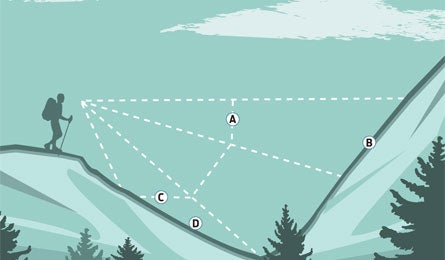Skills: Mind Over Mountain

'Illustration by Supercorn'
Overcome mental fatigue and you’ll turn a painful uphill slog into positive trail time, says Dennis Proffitt, M.D., a University of Virginia researcher studying human perceptions of slanted terrain. Why? The brain’s messages about hills ahead are based, in part, on your energy level. If you’re feeling rested and strong, you may barely register a moderate rise, if you’re fatigued and weak, mild slopes take on mountainous proportions. Low energy reserves trigger the brain’s self-preservation mechanism to call a halt when the going gets tough. In a survival situation, quitting before you burn your body’s backup energy supply could save your life, but when you’re trying to push your limits, this mental safeguard is just a buzzkill. Use these tips to trick yourself into summiting big slopes—no matter what your mind might be telling you.
Stay fueled
“Our brains scale the world to fit our body’s capabilities and protect us from expending more energy than we have,” says Proffitt. In a 2010 study, participants drank eight ounces of either a sugary drink (packed with glucose) or a diet drink (glucose-free) and were then asked to estimate a hill’s grade. The glucose-depleted group consistently overestimated the angle while the sugar-high group was more optimistic. The lesson? Ample energy reserves help curb the mental fatigue that makes a tough climb seem even tougher. Keep blood-glucose high by snacking often and remember that heavy packs and rugged terrain sap energy reserves quickly, so plan to eat more calories, rest often, and lighten your load to give yourself a psychological edge.
Don’t let physics psych you out
When viewed from a distance, a hill’s top and bottom seem equally distant, and foreshortening makes uphills appear steeper and downhills appear shallower than they really are. Avoid long-distance judgment calls because looking toward the hill’s apex exaggerates its angle; Train your eye on the terrain immediately ahead, says Proffitt.
Keep a positive attitude
Mood factors in estimating physical capabilities, and Proffitt’s research suggests that people regularly perceive slopes at double to quadruple their steepness—which can make climbing them seem impossible. Low self-esteem and fear add to higher hill-grade estimates, so reminisce about positive experiences, focus on personal strengths to build self-confidence, sing songs, play trail games, and stay calm to keep morale high.
Bring good company
Compared to solo hikers, research shows that groups of two or more perceive hills’ angles as more climbable. “Having [hiking partners] ‘takes a weight off your shoulders’ and makes terrain seem less threatening,” says Simone Schnall, a University of Cambridge psychologist. Schnall’s research suggests that even thinking of a supportive friend is enough to reduce perceptions of steepness. Going it alone? Bring a picture or token to remind you of a loved one.